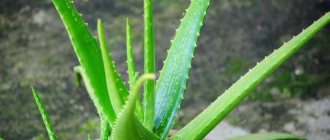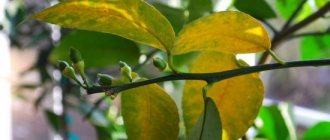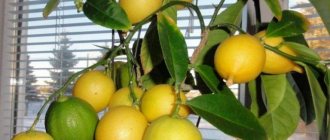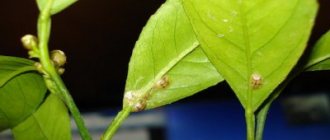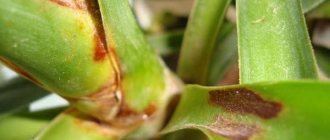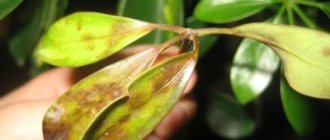Lemon, like other citrus fruits, is an exotic plant, but it is very popular in home floriculture. In many houses and apartments today you can see this beautiful tree with white fragrant flowers and healing vitamin fruits.
Of course, a lemon tree requires the creation of certain conditions for cultivation and maintenance, so various problems often arise in the process. For example, quite often lemon leaves turn yellow and fall off, and there can be many reasons for this condition.
Why do the leaves of indoor lemons dry out?
As a rule, most of the problems when growing lemons at home lie precisely in improper care, since the plant requires certain conditions. If leaves dry in small quantities on a tree, especially in mature specimens, this is not always a problem, and most likely indicates a natural seasonal replacement of foliage. It is necessary to sound the alarm when the lemon’s leaves not only fall off, but also its trunk and branches dry out. In this case, the plant needs urgent help and identification of the exact causes.
Humidity and temperature
Air humidity and temperature are two more important criteria, without which it will not be possible to grow a healthy lemon. Have you noticed that the leaves of your lemon are drying at the edges and curling? This means that the temperature and dry air in the room where the plant is grown is too high. Since lemon is a tropical plant, it does not tolerate excessive dry air very well.
Excessive dry air and high indoor temperatures can cause lemons to shed their leaves.
The optimal temperature for growing tangerines and lemons indoors is 20-23 degrees, and humidity is at least 70%. To increase the humidity in your home to an optimal level, you can use a humidifier. If it is not there, you can simply place containers filled with water near the plants. You also need to periodically spray the lemon with water from a spray bottle.
We invite you to read Why chickens lay blue eggs
Cold and sudden temperature changes can also have a detrimental effect on the plant. Cold air can cause leaves to fall off a tree. Therefore, protect lemon from drafts and cold.
What to do
If your lemon leaves are drying around the edges, it is quite possible that the cause is insufficient watering and low indoor humidity. Very often, flower growers do not think about how important the microclimate in the house is. It would seem that you are consistently watering the citrus plant with small portions of water, but it still weakens before your eyes.
In this case, you need to increase the air humidity. This problem often occurs in winter when heating devices are running in the house. What the gardener is recommended to do is not only regularly irrigate the citrus substrate, but also spray it with a spray bottle almost daily. A subtropical indoor plant will respond favorably to such care. Another important point: if necessary, place a container of water next to the flower pot.
To prevent lemon leaves and twigs from drying out, pay special attention to the quality of the water with which you water the substrate.
Even if you use tap water, it should be at room temperature. Don't forget that it also needs to be pre-defended. Only when the chlorinated components settle to the bottom will the liquid become suitable for moistening the substrate in which the homemade lemon has taken root.
You are unlikely to be able to revive dried lemon leaves: you will simply need to cut them off. But to do everything necessary to ensure that in the future the homemade lemon tree does not dry out, but develops to its fullest, is already within your power, even if you have not had any experience in growing indoor flowers. Take care of the integrity and health of the branches and tips of lemon leaves: revive and save them from drying out, and continue to take watering features seriously.
Video “Restoring Dried Lemon”
Citrus varieties can be cultivated in any enclosed space where conditions that are comfortable for them are maintained. But yellowness often appears on the leaves, which does not go away for a long time, causing them to fall off. It is necessary to find out what is causing the problem in order to figure out how to preserve the lemon.
If the conditions are not maintained properly, the leaves of the lemon begin to dry out around the edges.
Why homemade lemons don't bloom?
Sometimes it happens that citrus does not bloom for a very long time. In this case, the tree can be encouraged to flower by grafting with a cultivated cutting. After this, flowers will appear in 2-3 years. The reason why homemade lemons do not bloom may be the lack of a cool winter (at a temperature of 12-15°C), when the plant begins to develop flower buds. In a warm room, without a dormant period, citrus may not bloom. In addition, the tree may lack trace elements.
Lemons grown from seeds very rarely bloom and bear fruit. To achieve flowering, it is necessary to graft a branch of a fruiting plant. Flowering will occur in 3-4 years.
When planting lemons, you should know that some varieties bloom annually, while others bloom once every 4-5 years.
Watering with bad water
Why do the tips of the leaves of indoor lemons dry out is a question that worries many. It would seem that you have read all the basic recommendations from experts, you know what and how to do so that your home shrub quickly takes root in its new environment and at one point begins to form fruits. But something went wrong, and now the lemon tree faces a sad fate, as it is actively shedding its dried leaves.
Finding out the cause of the problem is not difficult, since there are only a few of them. The first thing you should pay attention to is the peculiarities of watering an indoor lemon tree.
It’s one thing to know that the root system of a lemon can dry out or rot if you do not approach the regularity and intensity of watering correctly, and quite another to understand that the quality of water is of great importance for your indoor plant. In the process of growing lemon at home, this is a basic requirement.
In greenhouses and botanical gardens, professional flower growers use special, pre-settled water. Of course, spending money on purified water for irrigation is an unaffordable expense for many. However, there are some things you can do at home.
The main thing is to understand what exactly is different about the liquid for irrigating the substrate, which is purchased by experienced gardeners, and what nuances are typical for ordinary tap water. Interestingly, the second option is not recommended for moistening the soil in which indoor lemon grows.
The thing is that such water contains chlorine and fluorine. These mineral elements can cause a lot of damage to a dried out indoor lemon tree. If you constantly saturate the plant with such components, your indoor flower will suffer significantly as a result: the tips of the leaves may turn yellow and dry out.
Overfilling or drying the soil
Even taking into account the fact that the plant is considered subtropical, and therefore loves moisture and high air humidity, it is still undesirable to fill it with water excessively. Let's say you very often moisten the soil composition of the lemon and spray the tree. In addition, it happens that the pot does not have drainage holes, which will only worsen the situation.
What does the florist who made a mistake deal with as a result? The soil in the flowerpot gradually becomes compacted and the pores become clogged. Now the air that the rhizome needs no longer circulates so easily in the substrate. Sooner or later, the domestic tree in the house simply dries out, since the root system begins to rot due to excess moisture. The indoor lemon drops its leaves, and all because due to the high density of the soil in the pot, the rhizome does not receive nutritional components.
But the main thing in caring for a home lemon tree is the golden mean. If excessive watering can destroy a plant in a matter of weeks, a lack of moisture in the soil can also cause a lot of harm. If you do not water your indoor shrub regularly, the soil gradually begins to dry out. The rhizome again does not absorb all the necessary beneficial components.
To prevent an indoor tree from curling its leaves, it is necessary to work out the specifics of its watering.
In the periods between moistening the substrate, be sure to monitor the condition of the soil: as soon as it becomes a little damp, you should start irrigating the soil again. Do not wait until the earthen ball dries completely. In this case, excessive watering will create a real stressful situation for the indoor shrub. The problem can be solved by watering the soil with small volumes of water approximately once every 2-3 hours. This way you will bring the lemon back to life after water fasting.
How to save a lemon
You need to care for your indoor lemon properly. Place the plant pot in the southern part of the house and provide additional lighting if necessary. For example, turn on the lamps for a short time in the evening. When watering, do not overwater the citrus tree, but try not to let the earthen ball dry out.
Pay special attention to regular feeding.
Nutrient mixtures need to be alternated. If desired, buy special complex compositions at the flower shop. In autumn and winter, fertilization stops. Another important point is pest control. To avoid having to remove fallen leaves later and save a bush that has shed all its green mass, carefully inspect it from time to time. It is also advisable to treat the tree with special insecticidal substances as an effective prevention.
When growing indoor lemons, in some cases problems arise due to improper care and maintenance of this whimsical plant. By eliminating the cause of the tree, you can regularly obtain a rich harvest of fruits. Failure to follow care recommendations can lead to the death of the citrus.
Reasons for the falling of citrus ovaries and fruits
If your homemade lemon drops its ovaries or even already grown fruits, this is a reason to take a closer look at the plant. Perhaps everything is fine with the plant: it is simply too young and there are too many ovaries. Another option is to remember if you moved the pot during flowering. Even a little bit. Even with good intentions, give the plant more light. Citrus fruits are very sensitive to movement, and minimal movement or turning of the pot will cause them to shed their ovaries.
And now a subtlety that will help distinguish the described situations from real problems. A plant that has enough of everything in life drops its ovaries and leaves its leaves in place. Which at the same time have a healthy bright green color, normal size and are not damaged. If something is wrong with the leaves, it’s time to save the lemon.
Why does a lemon drop its leaves?
At different times of the year, citrus sheds its leaves, but more often this can be observed in the autumn-winter period. The reasons why lemon leaves fall are usually associated with unfavorable conditions in which the tree is kept.
With a lack of light, the plant becomes depleted and begins to lose foliage. Quite often this happens in winter. In this case, additional illumination with special lamps is required.
Other reasons why a lemon drops its leaves are dry indoor air, lack of nutrition, insufficient watering, a cramped pot, overcooling of the roots, acidification of the soil, a sudden change of location, and premature flowering. To eliminate this problem, you need to provide the plant with regular watering and timely application of fertilizers. If the pot becomes too small, the tree is transplanted into a larger container. To prevent hypothermia of the root system, you should water the citrus with water at room temperature or a little warmer. Do not keep it on a cold windowsill. It is important to regularly monitor the condition of the soil and its moisture. With excess moisture, the roots begin to rot, which leads to the shedding of leaves.
When transplanting a tree into a larger pot, the soil may become acidic. To avoid this, the new pot should be 2-4 cm larger in diameter than the previous one. Often the leaves fall off immediately after transplantation, so lemons are initially planted in spacious containers.
Since the lemon quickly gets used to its permanent place, it reacts negatively to the rearrangement and has difficulty getting used to new conditions, as a result of which it can shed its leaves.
Citrus leaves can fall off under the influence of pathogens and, for example, or. In order to promptly identify and eliminate pests, it is recommended to periodically inspect the tree.
What to do if a lemon has dropped its leaves? In some cases, the plant recovers on its own. However, it is necessary to exclude all possible causes: prevent drafts, ensure timely watering, optimal air humidity. Fertilizer is applied only if the plant is healthy. If the tree has been moved to another location, you need to return it to its original location.
Other problems when growing a lemon tree
The slender and graceful lemon is a whimsical crop. It is very picky about growing conditions. Negative factors can lead to unpleasant consequences. Let's find out what common problems flower growers face.
Lemon sheds its leaves
Often “leaf fall” begins at a tree in the spring-autumn period. When a crop sheds its leaves, this happens for the following reasons:
Lack of light. The problem often occurs in winter. Lack of natural light leads to yellowing and falling leaves. To get rid of the problem, the crop needs to organize artificial lighting in winter. Dry air. Without regular spraying, lemon leaves begin to lighten, the plant slows down and stops bearing fruit. Cramped pot. The plant needs to be replanted regularly. Each time you replant, you need to take a larger pot. Insufficient watering. The plant is moisture-loving, so it requires abundant and even watering. Hypothermia of roots. You cannot place the plant in cool apartments or place it on a chilled windowsill or loggia. Root system rotting. Excess moisture in the soil leads to rotting of the roots. If the cause is not eliminated in a timely manner, the plant will die. Soil acidification. An excess of minerals in the soil leads to acidification of the soil and subsequent death of the flower. Abruptly moving a plant from one place to another. Moving from one place to another becomes stressful for the lemon. In a state of shock, the plant can drop all its leaves. Impact of insect pests. Premature “leaf fall” occurs due to damage to the plant by scale insects or spider mites
It is important to regularly inspect the plant for pests. When the first signs of pest infestation appear, take emergency measures to exterminate them.
Lemon has no color
Every gardener wants to get lush flowering from plants. A lemon may not bloom for several reasons:
- No wintering period. The wintering crop must be placed in a room with an air temperature of +15 degrees. It is under these conditions that the formation of flower buds begins. A tree that is located in a warm room all year round (from +20 degrees) will not bloom.
- Poor soil. For active flowering, lemon requires mineral components. Regular fertilizing will help provide the soil with nutrients.
You also need to know that some varieties of lemon can bloom annually. But other varieties can produce color only once every 4-5 years.
Lemon has no fruit
It often happens that the crop actively blooms, but does not form fruits. what are the reasons for this? Fruits are not able to form for the following reasons: lack of light, low air humidity, poor soil.
The lack of regular feeding is fraught with the following state of the plant: the ovary begins to form, but its size is no larger than a walnut, then it crumbles. In poor soils, lemon fruits can form, but they remain small and do not reach normal size.
Lemon is a demanding crop. In order for a flower to begin to bear fruit, it needs to create ideal growing conditions. A plant can react negatively to a variety of factors - from drafts to relocation to another place.
The ovaries and fruits on the lemon fall off
If fruits form on the plant, but fall off after some time, this may be due to the following unfavorable factors:
- dry air;
- exposure to drafts;
- sudden change in temperature in the room;
- lack of nutrients in the soil;
- parasitism on lemon by scale insects or spider mites.
During the fruiting period, the plant reacts to the slightest changes. A deficiency of nutrients in the soil leads to a decrease in yield. To stabilize the fruiting of lemons, it is necessary to regularly add fertilizers consisting of potassium to the soil (an analogue is a solution of wood ash).
It is also important to note that the lemon begins to drop its fruits; if it “feels” it, then it is not ready to bear fruit. It is generally accepted that each fruit should have 10 leaves.
If there are fewer leaves, then the formed ovary must be removed.
If the plant is ready to bear fruit, then it is necessary to form a load. No more than 2 fruits should develop on one branch; if there are more, then the excess ones must be removed.
Pests and diseases
Lemons in the house can “pick up” unwanted guests - spider mites, scale insects, aphids. Parasites appear along with infected seedlings, from neighboring indoor flowers and even bouquets. Severe pest damage causes leaves to yellow and fall off.
The most dangerous is the spider mite. This is such a small parasite that its reproduction is often unnoticeable - until the leaves are covered with yellowish dots and a coating of cobwebs. The pest settles on the underside of the leaf, sucking the juice from the tissues. The fight against ticks includes the following measures:
- warm shower;
- spraying the crown of the plant (mites do not like moisture);
- three times treatment with Fitoverm at weekly intervals.
Infection of lemons with scale insects and false scale insects is common. Adults are motionlessly attached to leaves and stems, overgrown with a brownish shell. Their larvae, vagrants, quickly spread throughout the plant. The pest is destroyed by mechanical and chemical methods.
Folk remedies also help in the fight against aphids - tobacco-soap decoction, garlic infusion.
Among diseases, lemon is most often affected by gommosis, or gum disease. The disease can be caused by improper care - deepening of the root collar, excessive watering and soil compaction, fungal infections.
Diseases and their treatment
The shedding of leaves by a citrus plant is not always associated with violation of care rules and unfavorable indoor conditions. Often the problem occurs due to diseases affecting the lemon. In most cases, it is easy to detect them; it is enough to know the characteristic symptoms.
Most diseases are easily treated at an early stage. If symptoms are detected too late, the plant most often dies.
Gommoz
Hommosis is a fungal disease that affects the branches and trunk of a plant. The proliferation of fungal infections is provoked by excessive air and soil humidity, damage to the bark, deepening of the root collar, and excess nitrogen.
The symptoms of the disease are as follows:
- brown spots form on the branches and trunk;
- the affected areas die and crack;
- gum appears from the damage (a sticky, quickly hardening, golden-colored mass).
With gommosis, sap flow is disrupted, which is why the leaves do not receive enough nutrients. They wither and fall off.
What to do to save lemon from gommosis:
- All spots on the plant bark are cut off with a sharp, disinfected knife. If there are too many lesions on the branches, they are removed.
- The cut areas are treated with a three percent solution of copper sulfate. Then the entire plant is sprayed with the product.
- The cut areas are covered with garden varnish.
Treatment is repeated three times with an interval of 7 days or until the signs of the disease disappear.
Root rot
Root rot is another fungal disease. It affects the roots, so the problem is usually noticed when the lemon begins to shed its leaves.
The cause of the disease is considered to be waterlogging of the soil, watering with cold water, deepening the root collar, and planting in contaminated soil.
To get rid of the disease, the following methods are used:
- The tree is being dug up. The roots are cleared from the soil.
- The root system is inspected. Remove all affected parts.
- The roots are treated with a solution of potassium permanganate or copper sulfate. You need to soak it in the solution for at least half an hour.
- The tree is transplanted into disinfected soil.
For a week after transplanting, avoid watering the lemon at the root. Instead, the crown is sprayed daily. A week later, the lemon is watered with a root formation stimulator.
Tristeza
Tristeza is a viral disease. Its first symptom is loss of foliage. Then the shoots and bark of the plant die.
Weakened lemons become infected with the disease. It is carried by insects and some types of citrus fruits.
Tristeza has no cure. The infected plant dies.
Melseko
Melseko is another incurable disease. Its main symptoms are dropping leaves and turning the cut branches red. Develops with improper care.
Anthracnose
Anthracnose is a disease caused by a fungal infection. It often attacks plants in the home and causes them to drop their leaves.
The list shows its signs:
- leaves turn yellow and fall off;
- the plant sheds inflorescences and buds;
- young shoots die off;
- Red spots appear on the set fruits.
To cure a plant, all affected leaves and shoots are plucked from it. The tree is sprayed with “Fitosporin” or a 1% solution of Bordeaux mixture. The treatment is carried out at least 3 times.
Temperature
Have your lemon leaves started to curl into a tube at the ends and then turn yellow? The reason is probably due to insufficient watering of the plant. It is best not to let the lemon soil dry out, as this can lead to drying out and death of the plant. The soil in the pot should always be slightly damp. But if the soil does dry out, it needs to be moistened gradually, with small portions of water at intervals of several hours. Sharp watering of a lemon after a “drought” can negatively affect the plant, and it will shed its leaves.
This is what happens if you don’t water the lemon for a long time and the soil dries out.
When overwatered, a lemon leaf begins to turn yellow near the base.
To eliminate the effects of overwatering, the plant should no longer be watered for several days to allow the soil in the pot to dry out. If there is too much moisture, be sure to transplant the lemon into a new pot, after drying the roots a little before planting.
It is also important not to forget about drainage
Signs of regular flooding of lemons - the edges of the leaves darken, gradually turn brown, and the roots may rot.
The lemon needs to be watered as the soil in the pot dries out. The frequency of watering is determined by many factors: the size of the pot and plant, temperature and humidity, and others. In summer, lemons need to be watered more often than in winter: if in winter a couple of times a week is enough for the plant, then in summer the number of waterings needs to be increased and the lemon should be watered every day or a little less often.
Read more: Why the ostrich hides its head in the sand, interesting facts
Lack of water is critical for indoor lemon, especially for a large tree with a strong crown. Moisture is constantly evaporating from the leaves. If the roots feel a lack of water, the plant sheds part of the crown, limiting the evaporation surface. Before falling off, the leaves turn yellow, most often at the petioles, but green leaves may also fall off.
To avoid this situation, you need to water your indoor lemon generously every day. If the air in the room is dry, it is recommended to regularly spray the leaves with a spray bottle; you can place an open container of water next to the pot. If the plant is close to heating devices, then the flow of dry hot air increases the evaporation of moisture from the leaves, and the lemon seeks to protect itself from this.
Yellowing of leaves is caused not only by a lack of water, but also by its excess. With constant overwatering, the roots become sour, oxygen access to them is disrupted, and rotting may occur. In this case, you should transplant the plant into a new pot, changing the soil and treating the roots with a solution of potassium permanganate. Young plants are especially sensitive to overwatering.
For homemade lemon, it is important to follow the rules and watering regime. A golden mean is needed, because both underwatering and overwatering are dangerous for the root system of a houseplant
Excessive moisture leads to waterlogging of the soil. Heavy soil interferes with air circulation, which leads to root rot.
Select the optimal watering regime, which keeps the soil slightly moist. It is better to water several times in small portions. To be on the safe side, you can put a small amount of drainage at the bottom of the pot: after all, if the top layer of soil is dry, this does not mean that there is not enough moisture inside.
Spots on leaves
Yellow spots on leaves . Yellowing of the leaves of a newly purchased lemon is normal. The plant is trying to adapt to new living conditions. Why do the leaves turn yellow after being at home for a sufficient time and what to do? We will find out further. Most likely, the leaves are damaged by sunburn or excessive fertilization.
As much as he loves sunlight, he should not receive them openly. The pot should be kept on the south side so that there is adequate lighting, but the plant needs to be slightly shaded in the summer heat. If the reason is excessive fertilizing, then you should wash the soil in the pot.
Brown spots on leaves . Lemon leaves begin to darken, turn brown and acquire a rusty tint due to a lack of phosphorus . It starts at the tips of the leaves and then spreads to the sides of the leaf.
Fruits also suffer from a lack of this microelement. The peel becomes thick and they themselves take on an ugly shape.
Lighting
If the leaves of your plant are covered with yellow or brown spots, this may indicate that the tree has received sunburn. Exposing lemons to direct sunlight for too long can cause the tips of the tree's leaves to darken and curl. This means that your tree has received sunburn.
Sunburn of lemon leaf
But burns on the leaves do not affect the entire plant as a whole; they occur only on the leaves on the side of the tree that was facing the sun. If you notice that your lemon has received sunburn , you need to remove it from direct sunlight; over time, the plant will recover on its own. But recovery will not occur quickly, so it is better to avoid placing the plant in direct sunlight.
Hypertrophied large leaves are a sign of excess light for lemon
Signs of a lack of light are clearly visible on the leaves: they become pale green and their size decreases. If there is not enough light, the lemon may even shed some of its leaves. It is especially important to monitor the light regime in the autumn-winter period, when there is less light and the plant may experience a deficiency. Therefore, you need to place the tree for several hours under a fluorescent or LED lamp for additional illumination of the plants. Signs of severe and prolonged light deficiency in lemons are shown in the photo for this article.
Lack of light in lemon - leaves become pale
The most optimal place for growing is well-lit, with fairly bright and diffused light, but not in direct sunlight. The plant is best placed on the western or eastern side of the house, or on the southern side.
Curling and drying of lemon leaves
The main signs of a plant's reaction to dry air are yellowing of the tips of the leaf blades followed by drying out. If no measures are taken, then yellowness quickly spreads throughout the tree, causing it to turn pale, dry out and die. This problem can only be prevented. To do this, you should spray the citrus with plain water from a spray bottle as often as possible.
To increase humidity, wet pieces of sphagnum, peat or expanded clay are placed on pallets around the lemon. Containers of water will also create additional humidity, as will radiators covered with wet towels. Frequent use of a steam generator, humidifier or ionizer has a beneficial effect on the microclimate.
Similar symptoms are caused by the xylopsorosis virus, which makes it difficult to identify the pathology. If a lemon is infected with this particular virus, it should be thrown away so that other plants do not become infected.
The foliage turned yellow after transplantation
Repotting is part of the necessary process of maintaining the growth and development of an indoor tree. But changing the soil itself is stressful for the plant. Citrus fruits react negatively to any changes in nutrition and often show this by the condition of the foliage.
If the tips of the leaf blades are covered with yellow spots, which also spread between the veins, the tree does not have enough beneficial substances contained in the new soil. The tree needs to be fed with specialized mineral compounds for citrus fruits. If there are none, any mineral fertilizer containing iron, phosphorus and potassium will do.
Why do indoor lemons turn yellow and fly off? Why do lemon leaves turn yellow? The lemon is sick, please help me identify the disease.
Why does lemon dry out?
Lemons grown at home require high-quality care. If there are any errors in maintenance, the crop does not bloom, get sick or bear fruit. Often the lemon dries out and its leaves fall off. To keep your houseplant alive, it is important to identify the factors that precede such problems and take appropriate action.
Why does lemon dry out?
Preventing yellowing of leaves
Yellowing leaves indicate serious problems. Even after eliminating the causes, plants take a long time to recover.
Therefore, it is important to take care of prevention in advance:
- To ensure optimal soil moisture, water is poured not into the pot, but into the tray underneath it.
- Provide optimal temperature conditions, lighting and humidity.
- Disinfect soil, planting material and garden tools.
- Follow the feeding schedule. Alternate complex mineral fertilizers with organic fertilizers.
- Lemons are replanted regularly. To check whether the roots have filled the pot, insert a toothpick into the soil. If it goes through slowly, then it’s time to replant the citrus.
Pest Control
There are a number of diseases and pests that cause citrus to shed its foliage.
Most often, the tips of the leaves of indoor lemons dry out due to spider mites. A characteristic sign of infection is drying of not only the leaves, but also the branches of the plant. There are thin cobwebs and small black dots on the leaf blades. To prevent the indoor tree from completely drying out due to the harmful effects of the mite, get rid of it. There are several effective treatment options:
- treatment of deciduous mass with an aqueous solution of laundry soap;
- illumination with an ultraviolet lamp;
- use of insecticides.
Scale insects are also dangerous for lemon trees. When it attacks, small growths appear on the leaves, which quickly grow, destroying the leaf blade. As a result, the lemon leaves dry out and fall off. Scale insects are combated with soapy water and insecticides.
Preventive measures
As a rule, preventive measures in this case mean providing the lemon with the necessary living conditions to maintain health, normal flowering and stable fruiting.
This measure allows not only to maintain the required level of humidity and cleanliness of the leaf plates, but also protects the plant from the appearance of pests such as spider mites and scale insects. It is important that the tree receives plenty of bright but indirect light for 12 hours each day.
Lemon loves peace, so you should not move it from place to place, trying to determine the most suitable living conditions. It is best to choose the optimal location right away, since when rearranging the plant, it can shed all its leaves at once without any additional negative factors.
All the leaves of the lemon have fallen off and the branches are drying up - what to do?
The success of resuscitation and treatment of a lemon tree depends on the speed of identifying the cause of dry leaves and branches. At the initial stage, the problem can be solved quickly, but delay threatens the loss of the tree.
If, due to excessive watering, the roots begin to rot , the lemon is transplanted into a new pot with a complete replacement of the soil. Damaged roots are cut off, the remaining ones are washed in a solution of potassium permanganate.
If sunburn appears on the leaves , the plant is moved to partial shade or covered with curtains from the scorching rays.
Damaged and dry leaves are removed , and young green leaves appear in their place.
The room maintains a comfortable air temperature and humidity level . The tree is placed under a shower every six months to wash away dust and spider mites from the foliage, but after that it is watered when the soil has dried 4-5 cm.
Symptoms
You can tell if there are problems with a lemon by the appearance of the bush. It begins to wither, the leaves lose their glossy shine and begin to dry out. The source of the problem can be determined by the nature of the tree's behavior.
Blackening of leaf tips
The appearance of a dark area on the edge of the leaf blade is most often associated with low humidity and high temperature in the room. This situation is caused by excessive watering and the use of hard water. The quality of liquid penetration into the soil should be checked; often the top layer is covered with a hard crust and does not allow it to penetrate inside.
Spots on leaves
If the leaves turn yellow and dry at the end, then with a high degree of probability the plant has contracted an infection or is being overcome by pests. The type of problem can be determined by the nature of the stains:
- when scale insects invade, the leaves become covered with yellow spots, which gradually grow;
- when infested with mites, numerous small dots form on the leaf blades;
- with fungal diseases, yellow-brown formations form, which eventually turn into scabs.
Problems most often arise when the soil was poorly treated before planting. For control, drugs with special action against infections or pests are used.
Curling leaves
Curling of leaves can occur due to watering with cold water. In summer, this may be a reaction to hot weather and lack of air humidity. The anomaly is often observed during mineral starvation
To do this, it is important to understand what element is missing. This can be determined by the appearance of the curled leaves:
- calcium - leaves lose color;
- magnesium - blanching is observed between the veins, leaf blades acquire a variegated color;
- boron - the leaves look wilted, and watering does not change the situation in any way.
The problem of curling is also common in plants affected by spider mites and aphids.
Drying twigs and green leaves
Problems with the root system often lead to drying. This may be due to excessive watering and the beginning of rotting of the shoots. This situation may also indicate infection with a fungal disease or be a consequence of transplanting into a large pot when the soil was selected incorrectly. To eliminate the risk of the plant becoming infected with a fungus, the plant should be treated with a fungicide.
Dropping flowers and fruits
If a lemon withers and drops its fruits, then in this way it can react to a change in environment. Regardless of the quality of care, when moving a plant to a new place, shedding is likely to occur. The reasons for this situation may also be the tree’s inability to bear fruit due to its age, soil depletion, or the plant’s need for more lighting or watering.
Pests of citrus fruits at home
Lemon is a plant that, unfortunately, is often attacked by various parasites , such as:
- Shield.
- Spider mite.
- Mealy nigella.
- Nematode.
- Aphid.
- Garden slug.
Scale insect: how to get rid of it?
Scale insects are the most common tree pest. The first sign of its presence is a sticky coating on the leaves of the lemon. Convexities of about 4 mm appear on the leaves and branches, almost invisible to the eye. Covered with a dense waxy shell, they become invulnerable to chemicals.
Sticky leaves can be controlled with insecticides . During watering, the poison from the leaves is washed into the soil, absorbed by the roots and the plant becomes poisonous.
ATTENTION! The scale insect that feeds on lemon juice dies. But despite the effectiveness of this method, the fruits become unsuitable for food.

